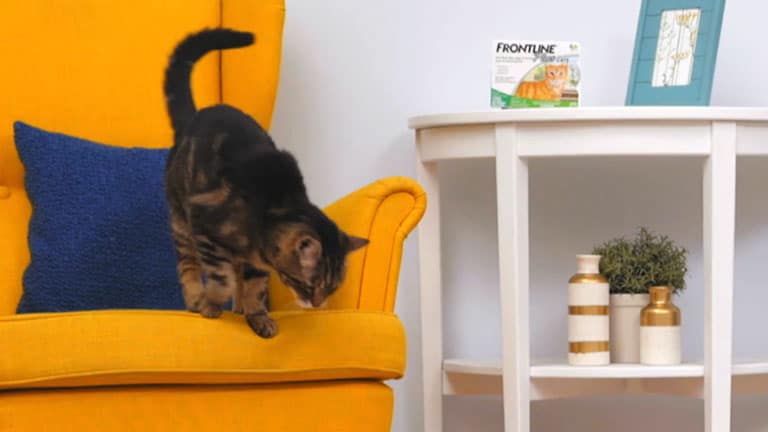Frontline Plus for Cats Review – What We Think Compared To The Competition
Contents of Article
Frontline Plus is an over-the-counter flea treatment made by Merial LLC, a subsidiary of Merial Limited. This animal health company was founded in Lyon, France in 1997 and is now owned by Boehringer Ingelheim, one of the world’s leading pharmaceutical companies.
It’s become one of the most popular flea treatments on the market and is frequently recommended by veterinarians as an alternative to prescription flea medications. But is it safe, effective, and worth the money?
In this Frontline Plus for Cats review, we’ll learn how this flea treatment works, whether or not it’s safe, if it’s really effective, and how it compares to other top products.
How does Frontline Plus for Cats work?
Frontline Plus is a spot-on product. You squirt it onto the back of your cat’s neck. From there, the active ingredients seep through his skin. The insecticides soak into your cat’s oil glands and become part of his natural oil distribution system. As oil spreads across the skin and coat, it brings with it a slow stream of lethal insecticides, poisoning fleas on contact.
One treatment of Frontline Plus is effective for about 30 days.
What is Frontline Plus for Cats made of?
It’s made from a combination of fipronil (10%) and S-methoprene (12%). These two insecticides work together to, respectively, scramble adult ectoparasites’ brains and keep larvae from developing into adults, therefore interrupting the flea lifecycle.
Fipronil
Frontline Plus for Cats is 10% fipronil. When an insect comes into contact with fipronil, their brain gets a dose of neurotoxins. The poisoned insect becomes hyperactive, loses coordination and general bodily control, and within 30 minutes, they’re dead.
Fipronil is classified as a Group C Possible Human Carcinogen. In lab studies, researchers found that rats developed more thyroid tumors when they were given both oral and dermal applications of fipronil. Nevertheless, it’s generally considered safe for cats.
S-Methoprene
Frontline Plus is 12% S-Methoprene. This insecticide is an insect growth regulator—commonly abbreviated as IGR. Insect growth regulators do what their name promises. They keep flea eggs from developing into adult fleas that can suck your cat’s blood.
S-methoprene mimics the fleas’ hormones and keeps them from reaching adulthood and reproducing. Though the EPA has received reports of IGR toxicity in cats, those reports are still under investigation. It’s still not known if the incidents were caused by the S-Methoprene in the product or another ingredient.
Does Frontline Plus for Cats work?
In general, Frontline Plus does appear to work. It’s been shown to kill fleas four hours after application. According to the company, another study showed that it could kill 100% of fleas within 12 hours of application.
Though it appears that, in general, Frontline Plus is effective, customer reviews are mixed. On Chewy, for example, 60% of reviewers give it a 5-star rating, while 20% give it just one star. Unhappy customers on Chewy and across the web say that Frontline doesn’t work or used to work and doesn’t anymore.
It’s unclear what’s going wrong. The customers may have applied it incorrectly, not stuck to a consistent application regimen, or washed the treatment off unintentionally. Or maybe Frontline Plus doesn’t work as consistently as it’s supposed to.
For now, we don’t have any proof one way or the other. Most veterinarians insist that declining efficacy is not due to any change in formulation but cat guardians’ failure to use it correctly.
Are fleas becoming resistant to Frontline Plus?
Because Frontline Plus has been so popular for almost 20 years and, for some users, seems to work less with each passing flea season, some speculate that fleas are becoming resistant to it. It’s not an unreasonable speculation. It makes sense that over multiple generations, a growing portion of the flea population might lack sensitivity to the toxins.
Michael K. Rust, PhD, a professor of entomology at the University of California, wrote a review of research on resistance to insecticides. He concluded that while it does appear that insects are developing resistance to some flea control products, including organophosphates, carbamates, and pyrethroids, there’s no indication that they’re getting any better at surviving exposure to phenylpyrazoles. That classification includes fipronil, one of the active ingredients in Frontline Plus for cats.
Since it doesn’t appear that the general population has mutated into Frontline-resistant super-fleas, it seems that if there’s a problem, it’s not because the fleas changed.
What kind of insects does Frontline Plus kill?
Frontline Plus can kill adult fleas, ticks, and chewing lice. In addition to killing adult parasites, it also inhibits the growth of flea larvae to keep the infestation from spreading. Frontline Plus can also control sarcoptic mange, but you’ll need to apply it multiple times each month to wipe out a population of mites.
Is Frontline Plus safe for cats?
Frontline Plus appears to be relatively safe, but it isn’t harmless. There are plenty of reports on the web saying that Frontline Plus caused cats to lose hair at the application site. We also know that fipronil is a potential carcinogen, a property which hasn’t been thoroughly studied in cats.
Frontline Plus is only safe and effective if you apply it to your cat’s skin—not when taken internally—so it’s important that it’s applied in between your cat’s shoulder blades and not ingested.
If you have multiple cats, keep them separated for 24-72 hours after application. This helps to ensure that your kitties don’t eat Frontline while grooming one another.
How does Frontline Plus compare to other flea treatments for cats?
Compared to other spot-on treatments for cats, Frontline Plus appears to be one of the best.
Despite all the reports about Frontline Plus not working as well as it used to, it’s one of the most consistently-effective products of its kind. With two powerful insecticides, rapid action, and the ability to interrupt the flea life cycle, Frontline Plus seems to outperform virtually every other over-the-counter treatment on the market.
Only Revolution—available by prescription only and about twice the price of Frontline—has a more consistent record of success. Revolution’s excellent performance record is balanced out by the fact that it may pose a health risk to you, the person who pets the treated animal.
In contrast to Revolution and so many other flea treatments, Frontline Plus appears to be safe for cats and humans.
Frontline Plus’ performance comes at a cost. It’s one of the most expensive over-the-counter flea treatments. A pack of six Frontline Plus treatments costs over $60, while comparable fipronil-based treatment Sentry FiproGuard costs just $18.37 for the same number of applications.
Overall, is Frontline Plus a good choice for cats?
If you’re willing to spend the money on it, Frontline Plus is one of the best over-the-counter topical flea treatments you can buy. Frontline Plus is relatively safe, appropriate for cats from 8 weeks and older, and has one of the best effectiveness reputations in the industry.








I clicked to make a comment on Frontline Plus for cats. I’m still steamed about my last purchase of this which did not work. After using it for years, suddenly I found I had a major flea problem. The local humane society said Frontline Plus doesn’t work and gave me Catego, which I now continue to use.